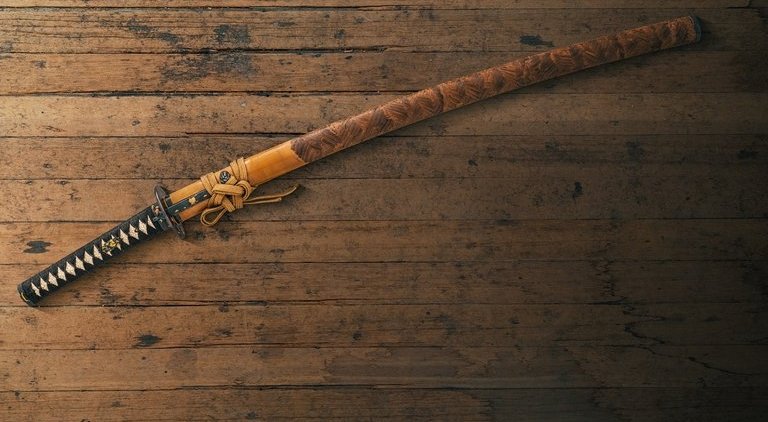-
Seishiken
晴思剣【せいしけん】
According to legend, Hosokawa Tadaoki used this sword to behead a tea servant, thereby clearing his troubled thoughts. -
Murasame
村雨【むらさめ】
A sword crafted by Tsuda Sukehiro, inscribed “Tsuda Echizen-no-Kami Sukehiro – Murasame” and dated February of the Enpō era. It is a particularly important sword designated as a Specially Important Sword.
Note: This is not to be confused with the fictional sword of the same name featured in “Nanso Satomi Hakkenden.” -
Murakumo-gō
村雲江【むらくもごう】
So named because its appearance in action is said to resemble billowing clouds. It was passed down in the Date family and is an Important Cultural Property. -
Nekomaru
猫丸【ねこまる】
A legendary tachi said to have been crafted by Sugawara no Michizane. A wakizashi bearing the same name is also traditionally held at Kitano Tenmangu. -
Shichiseiken
七星剣【しちせいけん】
[Straight Sword]
A National Treasure housed at Shitennō-ji. -
Heishi Shōrin Ken
丙子椒林剣【へいししょうりんけん】
[Straight Sword]
A National Treasure which, together with the Shichiseiken, is said to have been worn by Prince Shōtoku. It is housed at Shitennō-ji. -
Suiryūken
水龍剣【すいりゅうけん】
[Straight Sword]
An Important Cultural Property. This straight sword was formerly kept in the Shōsōin and is traditionally said to have been worn by Emperor Shōmu. It later became known as the favored sword of Emperor Meiji; a famous re-forging by Kanō Natsuo is also renowned. Both the blade and its mount are housed at the Tokyo National Museum. -
Midarare Mitsukane
乱光包【みだれみつかね】
[Short Sword]
An Important Cultural Property bearing the inscription “Mitsukane.” Made by a disciple of Raikoku Toshi-saku named Naka no Dō Raikoku, its unusually irregular (or “chaotic”) edge is notable. This short sword was passed down within the Tokugawa shogunate and is preserved at the Sword Museum. -
Midarare Tōshirō
乱藤四郎【みだれとうしろう】
[Short Sword]
An important sword inscribed with “Yoshimitsu.” Its name derives from the rare, irregular (or “chaotic”) edge characteristic of works by Awataguchi Yoshimitsu. It was passed down within the Kuchiki family. -
Sasa-nuki
笹貫【ささぬき】
A tachi made by Kobanohira and Namihira Yukiyasu. It is known as the oldest extant sword bearing the name “Namihira.” According to legend, its scabbard was so firmly embedded in the ground that when the sword fell, countless bamboo leaves pierced the tip of the blade. -
Kumokirimaru
蜘蛛切丸【くもきりまる】
[Wakizashi]
Inscribed “Omote: Yoshimitsu, Ura: Kameōmaru.” It is said that Oda Nobunaga dedicated this sword to Atsuta Shrine. -
Chisui
血吸【ちすい】
[Wakizashi]
→ See entry 17 (Dōjigiriyasutsuna). -
Tora Gozen
虎御前【とらごぜん】
A tachi reportedly awarded by Toyotomi Hideyoshi to Takenaka Hanbei (also known as Takenaka Shigeharu) in recognition of his achievements at the capture of Tora Gozenyama during the siege of Odani Castle. -
Kumokiri
蜘蛛切【くもきり】
→ See entry 18 (Hizamaru). -
Tokagemaru
蜥蜴丸【とかげまる】
A cursed sword from Aichi Prefecture. It is said that anyone who lays eyes on its blade will be stricken by misfortune. -
Goshin no Tsurugi
護身剣【ごしんのつるぎ】
A protective sword also known as the “Sun and Moon Guarding Sword.” -
Teppōkiri Kanemitsu
鉄砲切り兼光【てっぽうきりかねみつ】
Its name is derived from an incident in which Uesugi Kenshin is said to have cut through a musket on the battlefield. Although several Kanemitsu swords exist within the Uesugi family, it is unclear which one is being referenced here. -
Kanna-kiri Nagamitsu
鉋切長光【かんなきりながみつ】
Named from the legend that it was used to behead a carpentered youkai with a plane (kanna). It was presented by the Gamō family to Tokugawa Iemitsu and later given to the Mito Tokugawa family during the Taishō period. -
Nagasone Kotetsu
長曽祢虎徹【ながそねこてつ】
Revered as the “Yokozuna of New Swords,” it was crafted by Nagasone Kyōri. It is said that Kondō Isami of the Shinsengumi once possessed this sword. -
Raikiri
雷切【らいきり】
According to legend, this sword was used by Tachibana Dōsetsu (or by Tōji Kanren) to cut through thunder—or even the thunder god. -
Iwatōshi
岩融【いわとおし】
[Sword]
Appearing in the work “Yoshitsune-ki,” this four shaku two sun tachi with an ornate hilt is wielded by Musashibō Benkei. -
Hoemaru
吠丸【ほえまる】
[Tachi]
Appearing in works such as “Heike Monogatari” (Sword Scroll) and “Azuma Kagami.” -
Kogarasumaru
小烏丸【こがらすまる】
[Tachi]
(This entry repeats the earlier tachi by the same name.) -
Onimaru
鬼丸【おにまる】
[Tachi]
Appearing in the “Genpei Seisuiki” (Sword Scroll). -
Imakensu
今剣【いまのつるぎ】
[Short Sword]
Featured in works including “Yoshitsune-ki” and “Yoshitsune Monogatari.” With a blade length of 6 sun 5 bu and a hilt reputedly made of rosewood (according to “Yoshitsune Monogatari”), it is said to have been crafted by Sanjō Kōdai at the request of Kurama-dera and later entrusted as a protective sword to Minamoto no Yoshitsune. -
Murasame
村雨【むらさめ】
[Sword]
Appears in: “Nanso Satomi Hakkenden”
(This is a fictional sword distinct from the historical Murasame described in entry 32.)
Conclusion
In summary, we have showcased 56 distinctive names of Japanese swords—from historically significant masterpieces to legendary and myth-inspired blades. Each name encapsulates a story steeped in cultural heritage and mystique, offering a glimpse into the enduring legacy of Japan’s sword-making tradition. We hope this extensive list serves as a wellspring of inspiration for your creative projects, research, or personal exploration of Japanese history and art. Embrace the depth and allure of Japanese sword culture, and let these timeless names guide your journey into a world of beauty and valor.


Comments